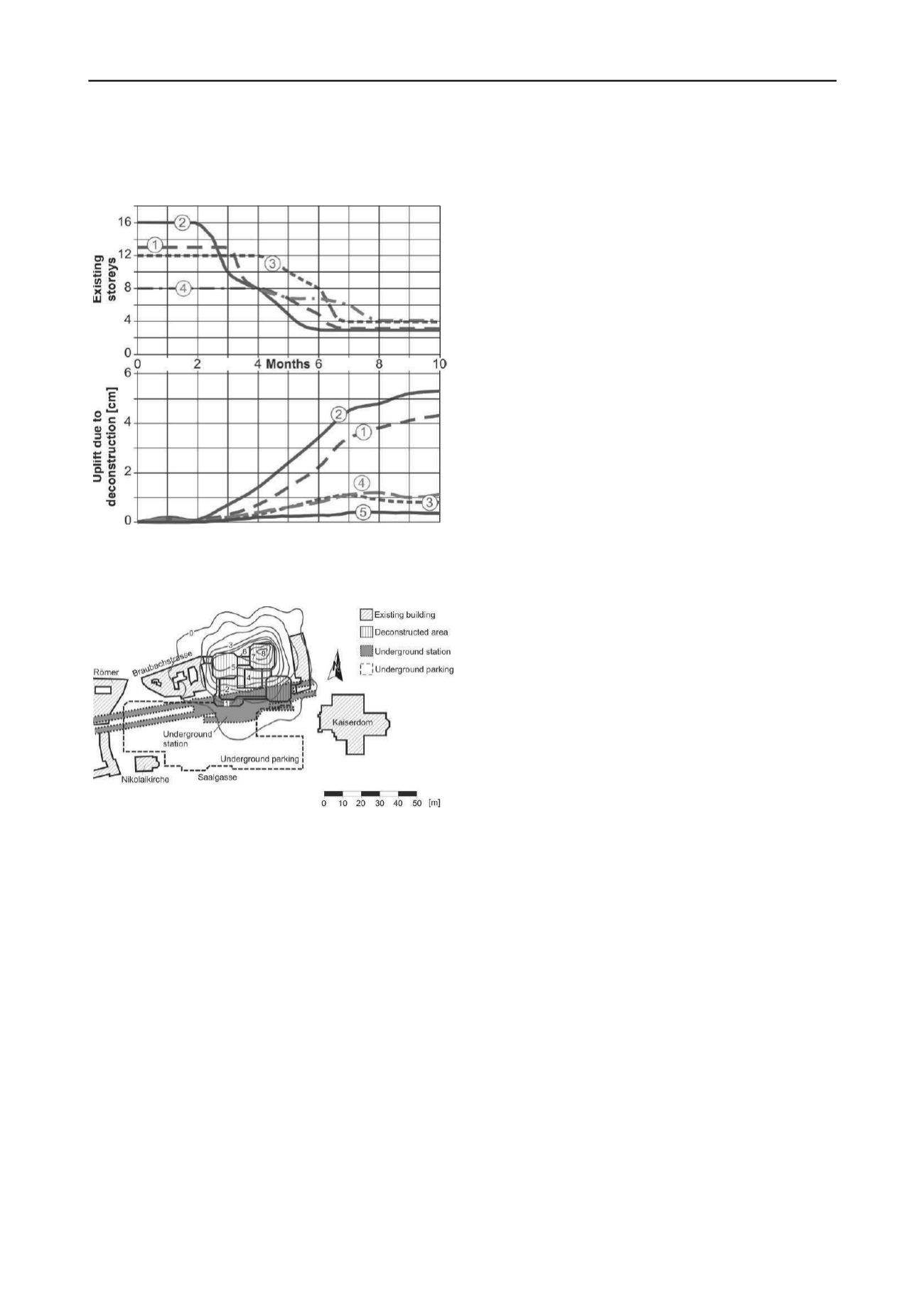
2026
Proceedings of the 18
th
International Conference on Soil Mechanics and Geotechnical Engineering, Paris 2013
measuring points 1 to 4 uplift between 1 cm and 5 cm was
detected in the deconstruction time (March to December 2010).
The measured uplift of measuring point 5 is less than 0.5 cm.
Figure 10. Measured uplift at selected measuring points.
Figure 11. Measured uplift of the whole project area [cm].
After the deconstruction down to the sublevels in December
2010, the modification of the sublevels began. In that phase the
loads only were changed insignificantly. The uplift of the whole
project area and the neighbourhood in October 2012 is drawn in
Figure 11. The uplift due to the reduced stress level of the stress
and time related deformation behaviour of the Frankfurt Clay is
continuously raising due to the consolidation processes. A
maximum uplift of 8.5 cm was measured in the area where the
most storeys were deconstructed. The uplifts fade down related
to the distance very quickly. So no dangerous deformations of
the neighbourhood were measured.
4 CONCLUSIONS
At the construction of excavations or the deconstruction of
existing buildings the soil is unloaded and relaxes due to the
reduced stress level. Cohesive soil materials like clay react
strongly time dependent. For example the tertiary Frankfurt
Clay relaxes time-delayed due to the unloading in the dimension
of centimetres. Regarding the guarantee of the stability and the
serviceability of structures in the neighbourhood the influence
of the arising deformation of the soil has to be taken into
account during an early planning stage and has to be considered
during analyses and design.
For verification of the analyses and to proof the design all
projects with large soil deformations have to be monitored by
means of the observational method. Only high-level analyses
compared with the observational method are the guarantee for a
safe construction phase for the project itself and the influenced
structures.
5 REFERENCES
Amman, P., Breth, H., Stroh, D. 1975. Verformungsverhalten des
Baugrundes beim Baugrubenaushub und anschließendem
Hochhausbau am Beispiel des Frankfurter Tons.
Mitteilungen des
Institutes und der Versuchsanstalt für Geotechnik der Technischen
Universität Darmstadt, Heft 15.
Breth, H., Stroh, D. 1974. Das Verformungsverhalten des Frankfurter
Tons beim Aushub einer tiefen Baugrube und bei anschließender
Belastung durch ein Hochhaus.
13. Baugrundtagung der Deutschen
Gesellschaft für Geotechnik in Frankfurt am Main
, 51-70
Breth, H., Katzenbach, R., 2000. Entwicklungen in der Geotechnik,
gespiegelt in 75 Bänden des Bauingenieur.
Bauingenieur 75, Heft
7/8
, 365-371.
Chambosse, G. 1972. Das Verformungsverhalten des Frankfurter Tons
beim Tunnelvortrieb.
Mitteilungen des Institutes und der
Versuchsanstalt für Geotechnik der Technischen Universität
Darmstadt, Heft 10.
CEN European Committee of Standardization 2008. Eurocode 7:
Geotechnical design – Part 1: General rules.
Dürrwang, R., El-Mossallamy, Y, Reininger-Behrenroth, M. 2007.
Neue Erkenntnisse zum Verformungsverhalten des Frankfurter
Tons.
Bautechnik 84, Heft 3
, 190-192.
Hanisch, J., Katzenbach, R., König, G.
Kombinierte Pfahl-
Plattengründungen
. Wilhelm Ernst & Sohn, Berlin.
Katzenbach, R., Moormann, C. 1999. Geotechnical fiel measurements
applied to a 240 m high office tower constructed by top/down
methods in Frankfurt Clay.
5th International Symposium on Field
Measurements in Geomechanics in Singapore
, 325-330.
Katzenbach, R., Hoffmann, H., Moormann, C., Vogler, M. 2001. Neue
geotechnische Konzepte für den technisch und wirtschaftlich
optimierten Hochhausbau.
Bauingenieur 76, Heft 7/8,
314-325.
Katzenbach, R., Turek, J., Vogler, M. 2002. Entwicklung einer
horizontal belasteten KPP am Beispiel der neuen Messehalle 3 in
Frankfurt am Main.
Bauingenieur 77, Heft 9,
393-398.
Katzenbach, R., Leppla, S., Seip, M. 2011. Das Verformungsverhalten
des Frankfurter Tons infolge Baugrundentlastung.
Bauingenieur 86,
Heft 5
, 233-240.
König, G. 1994. Innovationen im Bauwesen durch Forschung und
Entwicklung an den Hochschulen.
Mitteilungendes Institutes und
der Versuchsanstalt für Geotechnik der Technischen Universität
Darmstadt, Heft 32
, 87-112.
Janke, O., Zoll, V., Sommer, F., Waberseck, T. 2010. Palais Quartier
(Frankfurt HochVier) – Herausfordernde Deckelbauweise im
Herzen der City.
Mitteilungen des Institutes und der
Versuchsanstalt für Geotechnik der Technischen Universität
Darmstadt, Heft 86
, 113-124.
Moormann, C. 2002. Trag- und Verformungsverhalten tiefer Baugruben
in bindigen Böden unter besonderer Berücksichtigung der
Baugrund-Tragwerk- und der Baugrund-Grundwasser-Interaktion.
Mitteilungen des Institutes und der Versuchsanstalt für Geotechnik
der Technischen Universität Darmstadt, Heft 59.
Sommer, H., Katzenbach, R., DeBenedittis, C. 1990. Last-
Verformungsverhalten des Messeturms in Frankfurt am Main.
28.
Baugrundtagung der Deutschen Gesellschaft für Geotechnik in
Karlsruhe
, 371-380.
Viggiane, C. 1998. Pile groups and piled raft behaviour.
3rd
International Geotechical Seminar on Deep Foundations and
Bored and Auger Piles
, Ghent, 77-91.
Vogler, M. 2010. Berücksichtigung innerstädtischer Randbedingungen
beim Entwurf tiefer Baugruben und Hochhausgründungen am
Beispiel des PalaisQuartier in Frankfurt am Main.
Bauingenieur 85,
Heft 6
, 273-281.


